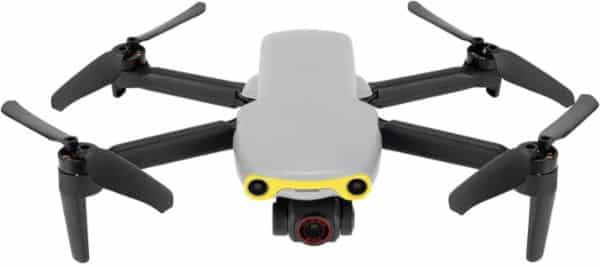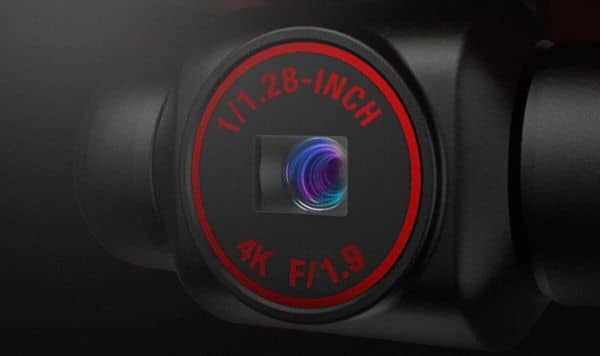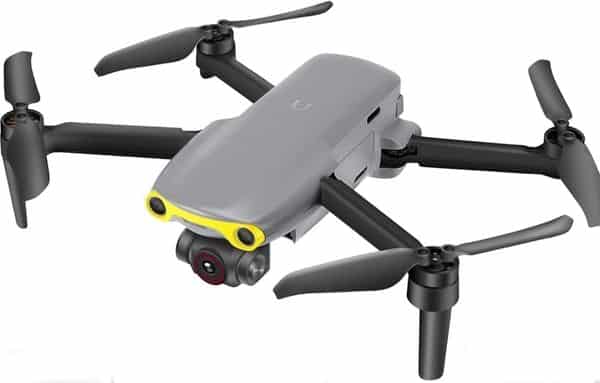The Autel Nano Plus drone is a fantastic option for novice and professional drone pilots looking for a drone with an exceptional camera and good flight time. With its large 1/1.28-inch sensor, RYYB filter, HDR capability, and multiple photography modes, this drone provides high-quality images and videos that are sharp, detailed, and true-to-life. Its ability to shoot 50MP still images and record 4K videos at 30fps, 2.7K at 30fps, and 1080p at 60fps make it an excellent choice for professional photographers and videographers. The drone also has several intelligent features such as a 3-way obstacle avoidance system, dynamic Track, quick shots and automatic return to home.
Key Features
- HD camera with 1/1.28-inch sensor
- RYYB Filter
- 50MP images
- Autofocus technology.
- Records videos in 4k at 30fps
- HDR videos and images
- Dynamic Track 2.1
- 33 mph top speed
- 28 minutes of flight time
- 10km transmission range
Hey fellow drone enthusiasts! Today, I’m excited to share with you my thoughts on the Autel Evo Nano Plus drone – a compact and feature-packed drone that has been impressing photographers and drone buffs alike. As a drone blogger, I’ve had the opportunity to review a wide range of drones, and the Evo Nano Plus is definitely one of the most impressive drones I’ve had the pleasure of reviewing. It’s the perfect drone for beginners and pros alike, offering an array of features that make it easy to fly and capture stunning aerial footage. So, without further ado, let’s dive into my review of the Autel Evo Nano Plus drone!
Autel Evo Nano Plus Review
 The Autel Evo Nano Plus drone boasts a sleek and compact design, making it highly portable and easy to bring along on all your adventures. Weighing under 249 grams, it falls under the FAA’s weight limit for mandatory registration, making it a hassle-free option for those who want to fly their drone without the added step of registering with the authorities.
The Autel Evo Nano Plus drone boasts a sleek and compact design, making it highly portable and easy to bring along on all your adventures. Weighing under 249 grams, it falls under the FAA’s weight limit for mandatory registration, making it a hassle-free option for those who want to fly their drone without the added step of registering with the authorities.
The drone’s body is constructed of high-quality materials that feel sturdy and durable, and it features foldable arms that allow for even more convenience when it comes to transporting and storing the drone.
The drone has powerful brushless motors and a GNSS receiver that can connect with three satellite systems, GLONASS, GPS and Galileo. It also has an ultrasonic sensor that helps stabilise the drone in areas with weak or no GPS signal.
One of the distinguishing features of this drone is its obstacle avoidance sensors; it comes with six binocular vision sensors, two each at the front, back and bottom.
This was one of the features that separated the Nano Plus from its main competitor at its release, the DJI Mini 2.
This feature, along with the large image sensor on the camera, is quite an impressive engineering feat for a drone of its miniature size and weight.
The drone is powered by a 2S lithium polymer battery that provides around 28 minutes of flight time; although this is the official time, most people will get approximately 25 minutes.
The drone comes with a remote controller that reminds me of a video game controller, it’s a solid controller that feels a little heavy, and unfortunately, it does not have an integrated OLED screen like the Evo 2 Pro controller.
I am a huge fan of drone controllers with their own screen, which means you do not have to attach your smartphone.
There is a smartphone attachment that pulls out from the top, and the controller has your basic buttons for stuff like take-off and automatic return to home and on the top, there is a dial for gimbal control and buttons to capture videos and photos. An additional button allows you to set your own function via the Autel Sky App.
The Autel Sky App allows users to access a range of flight modes, including Dynamic Track which enables the drone to follow a subject or object as it moves. The app also provides real-time telemetry data, such as altitude, speed, and battery life, which can help users monitor the drone’s flight and avoid accidents.
The Autel Sky app also includes camera controls, allowing users to adjust camera settings such as shutter speed, ISO, and white balance. The app also provides access to advanced camera features, such as HDR (high dynamic range) and RAW image capture.
Autel Evo Nano Plus – Camera

The Autel Evo Nano Plus drone is equipped with an impressive camera that boasts a 1/1.28-inch sensor with an RYYB filter, HDR capability, and 50MP still image resolution. Additionally, it can record 4K videos at 30fps, 2.7K at 30fps, and 1080p at 60fps, with the ability to record HDR videos as well. This camera system also has various photography modes such as AEB, burst, and panorama, making it a versatile option for photographers of all levels.
One of the most significant advantages of the Autel Nano Plus camera over the DJI Mini 2 is its large sensor size. A larger sensor means more light can be captured, resulting in higher-quality images with better detail, colour accuracy, and dynamic range. Additionally, the RYYB filter helps to further enhance colour accuracy, particularly in low-light situations, which can be challenging for cameras with small image sensors.
The HDR capability of the Autel Nano Plus camera is another significant feature that makes it an excellent choice for photography. HDR imaging is a technique that allows for capturing more detail and contrast in an image by combining multiple exposures. This feature is particularly useful when shooting scenes with high contrast or bright sunlight, as it helps to balance the exposure and prevent overexposure or underexposure in specific areas of the image.
How good is the camera? Check out the video footage below; the details and clarity are stunning.
Autel Nano Plus – Flight Features
The Nano Plus comes with three flight modes; they are standard, smooth and ludicrous, and the main difference between each flight mode is the speed. In ludicrous mode, the drone can reach its maximum speed of 33 mph; in standard mode, the speed is 22 mph; in smooth mode, the drone is limited to 11 mph.
You can also operate the drone in attitude mode; this is when the GPS is disabled or when there is no GPS signal in the area. This is the most challenging mode to fly, like flying a racing drone with no flight stabilisation feature. However, it is an excellent mode to practice and improve your flying skills and should only be used in wide open areas.
The drone has an official flight time of 28 minutes, although, depending on the weather and what you do with the drone, you may get around 25 minutes.
This flight time is slightly less than the DJI Mini 2, which has around 30 minutes and significantly less than the DJI Mini 3 Pro, which has about 34 minutes with its standard battery and 47 minutes with its intelligent plus battery.
The image transmission range is around 10km, which is similar to that of the DJI Mini 2 and slightly less than the Mini 3 Pro. Unless you have permission for beyond visual line-of-sight drone missions, the range shouldn’t be a factor in your decision on whether or not to purchase this or any professional drone.
Intelligent Features
The drone comes with several intelligent features; this includes the dynamic tracking feature that was not available when the drone was first released.
Using advanced machine learning algorithms, the Evo Nano Plus can track anyone or any moving object from many angles.
This is one of the most exciting features of this drone and fun to use; however, it does have certain limitations, especially when it is compared to the DJI Mini 3 Pro.
One of these limitations is that it cannot properly track fast-moving objects; you can see this in the video below.
This brings me to its other intelligent feature, which is the obstacle avoidance system. The drone has sensors on its front, back and bottom for a 3-way obstacle avoidance system.
Although the system works, the drone will just come to a stop; it’s not intelligent enough to stop and manoeuvre around obstacles. This may change with a firmware update, but it is a little disappointing, especially when compared to the DJI Mini 3 Pro.
Other intelligent features include Quick Shots, Hyperlapse videos, SkyPortrait and automatic return to home.
What is The Difference Between the Autel Nano and Nano Plus?
The only difference between the two drones is the camera, the Nano Plus comes with a 50MP 1/1.28-inch sensor with f/1.9 aperture and 85° FOV. The Nano comes with a 48MP 1/2-inch sensor with f/2,8 aperture and 84° FOV. The Nano Plus also comes with PDAF/CDAF autofocus technology.
DJI Mini 3 Pro vs Autel Nano Plus
Which is the better drone? If you’ve read this far, I think you will know my answer. Although the Nano Plus does come with better technical specs for the camera, they provide the same results in the real world. However, if you are a professional photographer, you may prefer the Nano Plus because of its bigger lens, RYYB filter and improved performance in low-light environments.
However, in every other department, the Mini 3 Pro is far superior; from its flight time, transmission range, intelligent features and obstacle avoidance system, the Mini 3 Pro is the clear winner.
Final Thoughts
The Autel Nano Plus is a fantastic little drone suitable for beginners and professional photographers. It has an excellent camera and several intelligent features, making it a joy to fly. It definitely is one of the best camera drones for under 250 grams.


